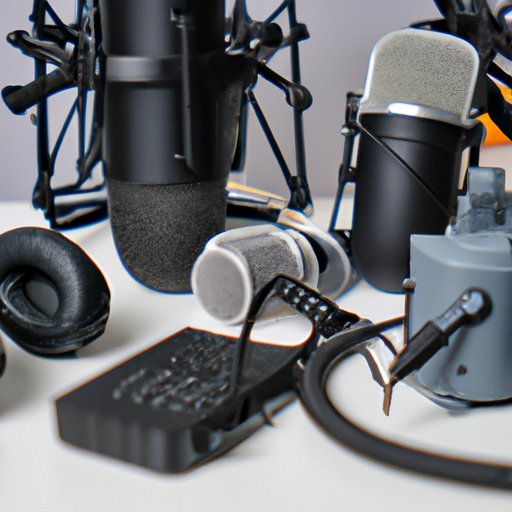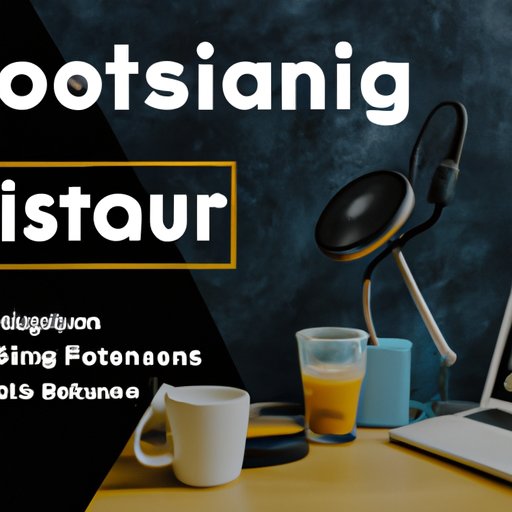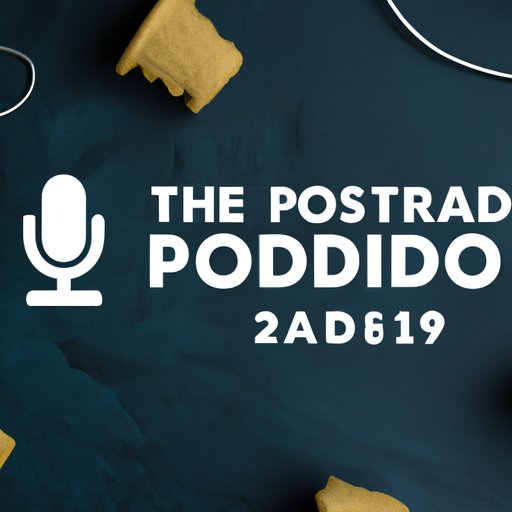Introduction
Podcasting has become one of the most popular forms of content delivery in recent years. According to the Pew Research Center, nearly one-third of Americans have listened to a podcast, and the market is expected to continue growing. Starting a podcast can be an exciting and rewarding experience, but it’s also a lot of work. To help you get started on the right foot, we’ve put together this comprehensive guide for how to start a podcast and make money.
Definition of Podcasting
Podcasting is a form of audio-on-demand technology that enables users to access digital audio files over the internet. It’s similar to radio broadcasting, but it allows listeners to choose what they want to hear and when they want to hear it. Podcasts are typically distributed in episodic formats and can be accessed on any device with internet access.
Overview of the Podcasting Market and Potential Audience
The podcasting market is booming. According to a report by Edison Research, there were an estimated 73 million podcast listeners in the United States in 2019. That number is expected to grow to over 100 million by 2024. There are podcasts available on a wide variety of topics, ranging from business to entertainment to health and wellness. The potential audience for your podcast is virtually limitless.

Choosing the Right Equipment for Your Podcast
Once you’ve decided to start a podcast, the next step is to identify the equipment you’ll need. Depending on your budget and the complexity of your podcast, the equipment list may vary. At a minimum, you’ll need a microphone, recording software, and a computer.
Identifying Necessary Equipment
The type of equipment you need will depend on the type of podcast you plan to create. For example, if you plan to conduct interviews or record multiple people at once, you’ll need a multi-channel mixer and multiple microphones. If you plan to produce music or sound effects, you’ll need a soundboard and other audio equipment. A good rule of thumb is to start simple and add additional equipment as needed.
Tips on Finding Affordable Equipment
The good news is that you don’t need to break the bank to get started. There are plenty of affordable options available. Many podcasting beginners opt for a USB microphone such as the Blue Yeti, which retails for around $100. You may also want to invest in a pop filter and acoustic foam to reduce background noise. You can find these items online or at your local music store.

Developing an Engaging Podcast Theme and Format
Once you have the necessary equipment, you’ll need to decide on a theme and format for your podcast. This is arguably the most important step in starting a successful podcast. Your theme and format should be engaging, informative, and easy for your audience to digest.
Choosing a Topic
Choosing a topic for your podcast can be daunting. It’s important to pick something that you’re passionate about and knowledgeable about. If you’re having trouble narrowing down your choices, consider your hobbies, interests, and expertise. You may also want to research other podcasts in your niche to get an idea of what works and what doesn’t.
Crafting an Engaging Format
Once you have a topic, you’ll need to decide on a format. Popular podcast formats include interviews, roundtable discussions, solo shows, and narrative storytelling. Experiment with different formats to see what works best for your show. It’s also important to keep your episodes concise and to the point. Most podcasts range from 30 minutes to an hour in length.

Building a Professional Website to Promote Your Podcast
Having a professional website is essential for promoting your podcast and growing your audience. Not only will it give you a place to host your podcast episodes, but it will also serve as a hub for all of your podcast-related content.
Establishing a Professional Brand
The first step in setting up a website is to establish a professional brand. This includes coming up with a name, logo, and tagline for your podcast. You’ll also need to register a domain name and set up hosting for your site. Once that’s done, you can start designing your website.
Creating a User-Friendly Website
When designing your website, it’s important to make sure it’s user-friendly. Your website should be easy to navigate and should feature clear calls to action. You’ll also want to include a section for podcast episodes, as well as links to your social media accounts. Finally, make sure to include an email signup form so you can capture leads.
Utilizing Social Media to Grow Your Podcast Audience
Social media is one of the most powerful tools for growing your podcast audience. It gives you the ability to reach a large number of people quickly and easily. However, it’s important to use social media strategically in order to maximize your reach.
Identifying Target Audiences
Before you start posting on social media, you’ll need to identify your target audience. Who are you trying to reach? What are their interests and pain points? Knowing who you’re trying to reach will help you craft engaging content that resonates with your audience.
Implementing Strategies to Reach Your Audience
Now it’s time to start posting. Leverage the power of hashtags to increase visibility and engage with your followers. You can also use paid advertising to reach new audiences. Finally, consider partnering with influencers and other podcasters to cross-promote your show.
Monetizing Your Podcast with Ads, Sponsorships, and Affiliates
Once you’ve established a loyal following, you can start monetizing your podcast. There are several ways to make money from your podcast, including ads, sponsorships, and affiliate programs.
Understanding Different Types of Ads
Ads are one of the most common ways to monetize a podcast. There are two main types of ads: pre-roll ads and mid-roll ads. Pre-roll ads are played before the episode starts, while mid-roll ads are placed in the middle of the episode. Both types of ads can be effective, but pre-roll ads tend to be more successful because listeners are more likely to stick around for the full episode.
Leveraging Sponsorships
Sponsorships are another great way to monetize your podcast. A sponsorship is a mutually beneficial arrangement between you and a company or product. In exchange for mentioning their product in your podcast, you’ll receive a fee or commission. To get started, reach out to companies in your niche and pitch them your show.
Setting Up Affiliate Programs
Affiliate programs are another option for monetizing your podcast. Affiliate programs allow you to earn money by referring listeners to products or services. All you have to do is promote the product or service on your podcast and link to it using your unique affiliate link. Whenever a listener makes a purchase using your link, you’ll receive a commission.
Conclusion
Starting a podcast and making money from it requires dedication and hard work. But with the right strategies and tools, you can create a successful podcast and generate revenue from it. Begin by investing in the necessary equipment, developing an engaging theme and format, building a professional website, utilizing social media to grow your audience, and monetizing your podcast with ads, sponsorships, and affiliates. With this comprehensive guide, you now have the knowledge and resources you need to get started on your podcasting journey.
(Note: Is this article not meeting your expectations? Do you have knowledge or insights to share? Unlock new opportunities and expand your reach by joining our authors team. Click Registration to join us and share your expertise with our readers.)
